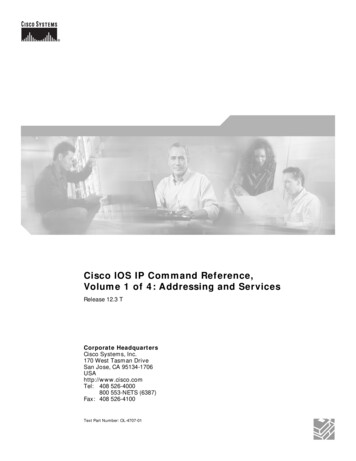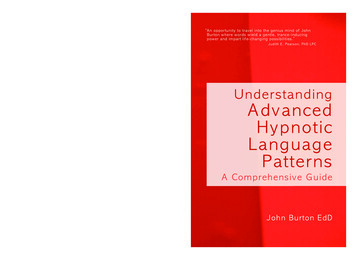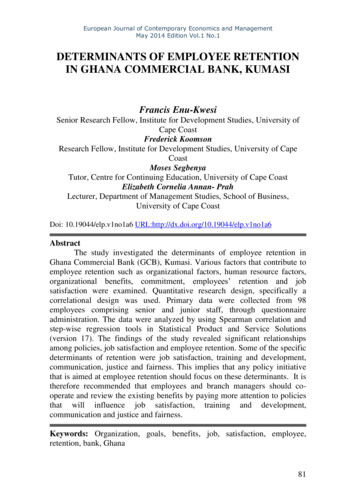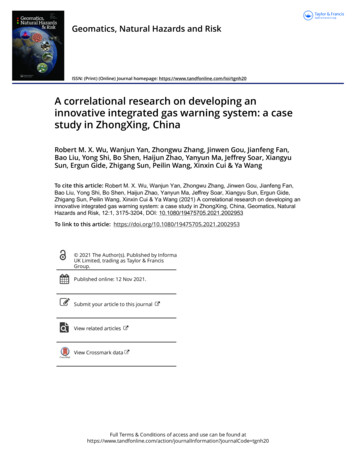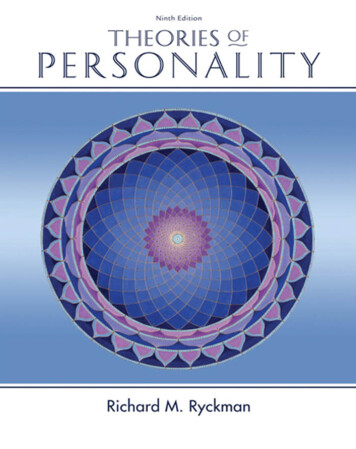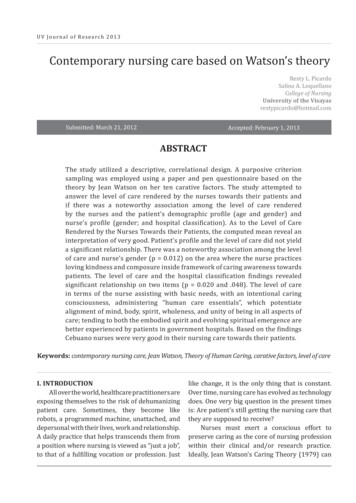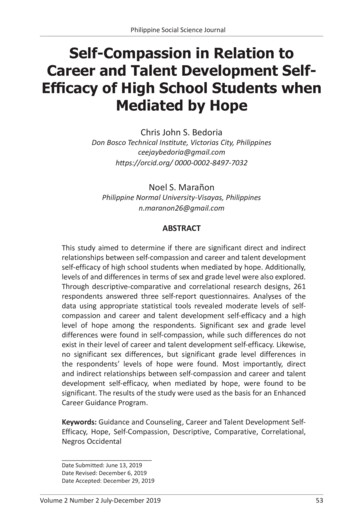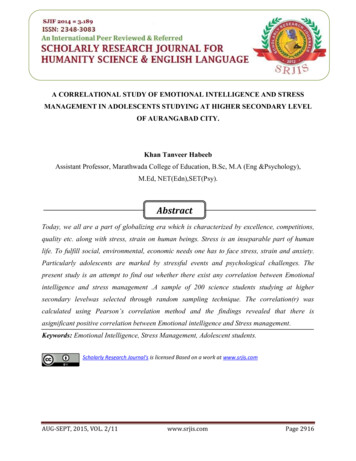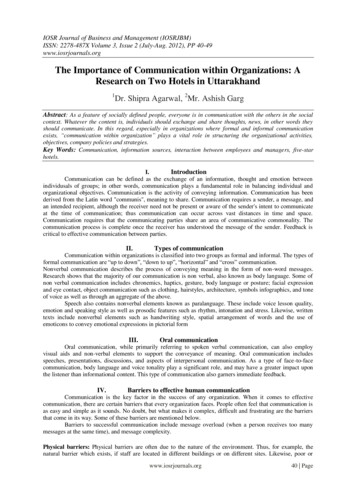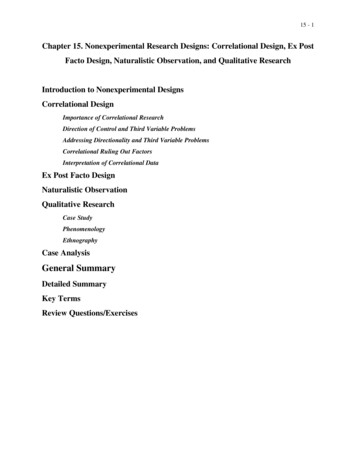
Transcription
15 - 1Chapter 15. Nonexperimental Research Designs: Correlational Design, Ex PostFacto Design, Naturalistic Observation, and Qualitative ResearchIntroduction to Nonexperimental DesignsCorrelational DesignImportance of Correlational ResearchDirection of Control and Third Variable ProblemsAddressing Directionality and Third Variable ProblemsCorrelational Ruling Out FactorsInterpretation of Correlational DataEx Post Facto DesignNaturalistic ObservationQualitative ResearchCase StudyPhenomenologyEthnographyCase AnalysisGeneral SummaryDetailed SummaryKey TermsReview Questions/Exercises
15 - 2Introduction to Nonexperimental DesignsWe have said much about true experiments and we have described their strength in drawing strong,confident conclusions. A word of caution is advisable. An experiment may use random assignment andinvolve manipulation of the treatment variable and still be essentially worthless as a basis for drawingconclusions. It is essential that rigorous controls, careful execution, planning, thoughtfulness, etc.,accompany a valid design. We have also noted the qualities of designs termed quasi-experimental. Recallthat these were characterized as designs in which the independent variable was manipulated but the studylacked random assignment of participants to conditions.As we have seen thus far in the book, experimental research is a very powerful tool for generating ascientific database for drawing cause-effect conclusions, for testing hypotheses and evaluating theory, foranswering questions and satisfying our intellectual curiosity, for systematic manipulation of variables, and,at times, for discovering principles that may be relevant to everyday life. After considerable discussion ofthe virtues of experimental designs, you might wonder why researchers would use other types ofnonexperimental designs. Actually, there are several good reasons to use nonexperimental designs. Manyvery interesting questions in psychology do not lend themselves to experimental designs. Some of thesequestions involve independent variables that simply cannot be manipulated by a researcher. If we wish tostudy the effects on a dependent measure of such naturally occurring variables as gender, ethnicbackground, intelligence, temperament, or body size, we cannot say to the participants, "For the purposesof this experiment, I am going to declare you a female, or a black, or a person with an IQ of 130!” Inaddition, some questions involve independent variables that could theoretically be manipulated by aresearcher but are not because the opportunity does not present itself, the financial cost would be too high,or the ethical concerns too great. For example, we may ask, "Do individuals who have left hemisphericbrain damage show greater verbal impairment than those who have comparable damage to the righthemisphere?" Obviously, it is not possible to randomly assign people to an experimental and control groupand then conduct brain surgery to answer this question. However, if we are to shed any light on thequestion, we are forced to look into the histories of people who have suffered brain damage as a result ofadverse circumstances. Similarly, as we have repeatedly explored the issue of TV violence and aggressivebehavior in children, we would certainly be interested in the effects of long-term (in terms of years)exposure to TV violence. I’m sure that you can see the ethical issues involved in randomly assigning agroup of children to watch violent television for several years!Thus, although nonexperimental research designs are not as powerful as experimental designs i.e., donot rule out as many alternative hypothesis (explanations), they provide us with options for pursuing
15 - 3interesting and important questions when experimental designs are not available. Figure 15.1 provides anoverview of the nonexperimental designs discussed in this chapter. Let’s explore some of these options.Figure 15.1 Overview of nonexperimental research methodsCorrelational DesignAs noted, there are ethical issues involved in an experimental study to assess the long-term effects ofTV violence on aggressive behavior in children. However, we suspect that you can imagine anonexperimental study that could assess the relationship between these two variables over the timespan ofseveral years. Using either a retrospective technique (examine data that already exist) or a prospectivetechnique (collect data across several years), you could record the degree of exposure to TV violence andthe number of aggressive incidents. Correlational research involves collecting data or searching outrecords of a specified population and ascertaining the relationships among the variables of interest. Suchresearch involves neither random assignment nor manipulation of an experimental variable.The two research procedures encountered most frequently, and also most sharply contrasted with eachother, are the experimental and correlational ones. Again, we repeat the important differences betweenthem. The experimental approach studies the causal relationship between manipulated variables and usesrandom assignment (or repeated measures), whereas the correlational approach studies the relationshipbetween unmanipulated variables and does not use random assignment. Other examples of this approachare: smoking history and health problems; alcohol use and GPA; education attained and salary levels, etc.We view these research methods as complementary techniques rather than competing ones. As you shallsee, they often serve different purposes and provide answers to different questions.
15 - 4Random assignment of participants and the manipulation of variables are absent in correlationalresearch because the events of interest have already occurred or are naturally occurring. The interest is indetermining how measures on one variable are related to measures on another variable. Often, inpsychology, the two measures are behavioral measures.The correlational approach is sometimes referred to as the study of individual differences becauseemphasis is placed on differences among individuals. For example, assume that we have a distribution ofindividual scores on one measure (Intelligence Test Scores—Test 1) and a distribution of individual scoreson another measure (Final Exam Scores—Test 2). The question asked of these data by a correlationalapproach is whether differences among individual scores on one variable (Test 1) are related to differencesamong individual scores on the other variable (Test 2).A statistical procedure called correlational analysis is used to ascertain the extent of the relationshipamong individual scores on the two variables (tests). This emphasis on individual differences contrasts withan experimental approach where interest is in comparing the average performance of a group in onecondition with the average performance of a group in another condition (single-subject designs are anexception).As you may recall from your introductory statistics course, calculating a correlation between twodistributions of scores (scores on Test 1 and scores on Test 2) results in a number called a correlationcoefficient. The strength of the relationship is indicated by the numerical value of the coefficient and itsdirection is indicated by a or - sign. If the individual scores are unrelated (no relationship), the numericalvalue of the coefficient is 0; if the scores are perfectly related on the two distributions, the numerical valueis either a -1.0 or a 1.0. Thus the numerical value of the correlation coefficient may range from a -1.0 to 0or from 0 to a 1.0, with variations in between. A positive relationship indicates that individuals scoringhigh on one distribution also tend to score high on the other distribution and that those scoring low on onetend to score low on the other. Put more simply, as individual scores on one distribution increase, theirscores on the other increase (e.g., the more one studies, the higher one’s grade point average). If therelationship is negative, then individuals scoring high on one distribution tend to score low on the other andthose scoring low on one tend to score high on the other. Again, put simply, as individual scores on onedistribution increase, their scores on the other decrease (e.g., the more one parties, the lower one’s gradepoint average).Correlational methods are used in virtually every scientific and professional discipline and they servemany purposes. Correlations between variables are often used to make predictions. When measures on twovariables are unrelated, i.e., correlation coefficient 0, knowing an individual's score on one variable is not
15 - 5at all helpful in predicting his or her score on the other variable. As the correlation becomes greater thanzero, the accuracy of predicting the individual's score on one variable, simply by knowing his or her scoreon the other, increases. And when the correlation is perfect, i.e., 1.0 or -1.0, prediction of an individual'sscore on one variable from knowing his or her score on the other can be made without error.While working on this chapter, a number of articles appeared in newspaper accounts and in popularmagazines dealing with correlational research. Some of these accounts are found in Table 15.1. They givean idea of the variety of problems that can be studied using correlational procedures. We do not describethe results of these reports because we have not read the primary source from which they came, nor havewe evaluated the care with which the studies were conducted. After reading the section on Third VariableProblems and Directionality, you may want to return to this table to evaluate the extent to which these twoproblems may be present in the description found in Table 15.1. You will most likely conclude that manyalternative explanations may be offered for the observed relationships.Although correlational research allows lawful relationships to be discovered that can lead to precisepredictions, causal statements can be made only with great risk because these methods lack randomassignment, active manipulation, and rigorous control over extraneous factors. Such variables as gender,group membership, racial characteristics, birthplace, and age are historical events over which researchershave little control. They are determined before the researcher arrives on the scene. The measures that arecorrelated are often personality variables or variables related to the characteristics of people. These
15 - 6variables generally cannot be manipulated. There are exceptions, of course. Some behavioral measures maybe manipulated but only with great difficulty. As we have seen, a question of ethics often arises, e.g.,cigarette smoking and lung cancer or cardiovascular disease, exercise and cardiovascular problems.Importance of Correlational ResearchStating that a causal relationship cannot be established by correlational research is not intended todevalue the great importance of this type of research. It is often extraordinarily important both in apractical and in a theoretical way. Research with this method has had a marked influence on the lives ofmany people and on policy formulations of legislatures, decisions of the judiciary, and actions of privateenterprise. A few well known examples are: correlation of smoking habits with lung cancer led to a warningon cigarette packs; the relation between exercise and lowered rates of cardiovascular problems hasstimulated increases in jogging, swimming, tennis, bicycling; correlations between socioeconomicconditions and educational proficiency provided a rationale for decisions involving equality in educationand school busing; and correlations between particulate matter in the air (pollution) and morbidity ratesprovided the impetus for clean air legislation.It is often the case that our interests are in prediction rather than in a cause-effect analysis. After weknow the correlation between two measures, we are able to predict one form of behavior from knowledge ofthe other. For example, there is a correlation between IQ test scores and success, as measured by grades inschool. Over the years considerable data have been gathered on this relationship and it is quite well established. With a quantitative measure of the relationship (i.e., correlation coefficient), we can predict withsome accuracy success in school simply by knowing a person's score on the IQ test.Similar examples emphasizing prediction occur when test scores are used as screening devices forselecting those students most likely to succeed in graduate school, medical school, law school, etc. In thelatter cases, individuals take examinations over certain specified material; their scores are obtained andprediction formulas then applied. Thus, predictions can be made on large numbers of individuals almostimmediately after obtaining their score. As we have noted, the accuracy of the prediction depends on thestrength of the relationship between the two forms of behavior. The stronger (higher) the correlation, thebetter the prediction.Discovering the relationship between two variables can be very valuable, especially if one behaviorthat can be easily and inexpensively measured permits us to predict behavior that is difficult, inaccessible,and expensive to measure. Knowing the relationship may also be of great practical value, especially foreducational systems. For example, special programs may be instituted to prevent problems from occurringamong those in need of help and to enrich those who are in need of challenge.
15 - 7Another example of correlational research that has proven useful relates to diagnostic purposes. After adisorder is observed, a search can be made for other behaviors or conditions that may vary (correlate) withit. The latter is especially the case if the disorder is difficult to detect or to diagnose accurately. If thesearch is successful and the correlation strong, then both the speed and accuracy of identifying the disordermay be substantially increased.The usefulness and value of a correlational approach are most apparent when studying the effects ofevents that simply cannot be studied in laboratory settings. This approach may be the only availablemethod when ethical considerations prevent manipulating the phenomena (e.g., abortion, drug use, sexualpractices, serious illness, suicide), when the phenomena are impossible to manipulate (e.g., male/female,black/white, temperament), or when studying the effects of natural disasters such as earthquakes, fires,violent storms, etc.Direction of Control and Third Variable ProblemsDiscussion of direction of control and third variable problems will illustrate the difficulties of inferringcause-effect when interpreting correlational data. With correlational research, we usually refer to predictorand criterion variables rather than independent and dependent variables. The measure (or behavior) beingpredicted is the criterion variable, and the measure (or behavior) from which the prediction is made is thepredictor variable. The use of this terminology emphasizes prediction rather than suggesting a cause-effectrelationship. However, there are occasions when individuals, be they scientists, writers, or laypeople, cometo cause-effect conclusions based on correlational data. They face a risk of drawing false conclusions whendoing so. In effect, they must deal with two different problems: the direction of control problem and thethird variable problem. We will give examples of both.To infer a cause-effect relationship requires that we specify the direction of control. Assume thatvariable X and variable Y are highly correlated such that increases in one are associated with increases inthe other. Does variable X cause variable Y to vary, or does variable Y cause variable X to vary? Withsome relationships the answer concerning the direction of control seems obvious but in other instances itcan be difficult to specify. Let’s assume that our correlational research on TV violence and aggressionshowed a positive relationship between these two variables. It would seem to be a natural inference toconclude that exposure to TV violence leads to (causes) more aggressive behavior in children. However, isthis necessarily the case? Are there alternative explanations for the observed relationship? Is it not possiblethat children who are more aggressive, for whatever reason, tend to choose TV shows with more violence?We will give another example of the direction of control problem. Let us say that a high, positivecorrelation exists between frequency of drug use (variable X) and difficulties in school (variable Y). We
15 - 8could say that the use of drugs was the cause of experiencing difficulties in school. On the other hand, anequally plausible conclusion is that having difficulties in school caused the individual to use drugs.The fact that in both of these examples we have a high correlation between variable X and variable Ydoes not help at all in our determining the direction of control. Our risk of coming to a wrong causalconclusion is not reduced. The only way to reduce the risk is to bring additional information to bear on theissue or, when permitted, to attempt an experimental approach and manipulate the important variables.Our problem is intensified in that the risk of error is even greater when we consider possible thirdvariable problems that may be present. For our example with the TV violence study, it is possible thatneither of the two variables causes the other. Rather, some other (third) variable may actually causechanges in the two variables that were measured. After giving this some thought, we are sure that you cancome up with a potential third variable. In our example that involved drug use, instead of drug use causingschool problems, or school problems causing drug use, a third factor (fourth, fifth, etc.) could have causedincreases in both drug use and school problems. For example, anxiety, depression, low self-esteem, orconflict within the home could give rise to both increases in drug use and increases in school problems. Inthis case, then, variables X and Y are related only through some third variable. Figure 15.2 illustrates boththe direction of control and third variable issues.
15 - 9Figure 15.2 Direction of control and third variable issues in correlational researchIt is sometimes difficult to avoid a causal conclusion and to maintain the proper perspective whenviewing correlational data. The consistent, highly publicized, positive correlation between cigarettesmoking and cancer seems causal. The more cigarettes smoked, the higher the incidence of cancer. Thisrelationship seems to suggest that the smoking of cigarettes controls whether or not cancer will occur. Yet,strictly speaking, we cannot say this based on human research. A third factor may be involved. It ispossible that only certain people with this factor smoke and that these people would contract the diseasewhether or not they did so. The more of this factor present the greater would be smoking and the possibilityof contracting the disease. If this were so, then increases in both smoking and cancer result from this unspecified third factor. The latter is very unlikely and, in fact, the few recent experimental studies that havebeen done suggest that it is certain ingredients in tobacco that may cause cancer. Third variable problemsare sometimes very difficult to detect and to deal with. Further, you can never be sure that they are absentwhen using correlational designs. However, some techniques are available for addressing the problem.Addressing Directionality and Third Variable ProblemsThere are several methods available that attempt to deal with the problems of directionality and thirdvariables. Although these methods are sometimes useful they do not solve the preceding two problems.Each has its problems. A full description of these methods is beyond the scope of this text. We mentionthem here for those of you who would like to pursue the problems further. A procedure that is sometimesuseful for addressing the directionality problem is a time-lagged correlational design. The essential aspectof this procedure is to determine a correlation between two variables at Time 1 and again later at Time 2.This technique is also referred to as cross-lagged panel correlation. The third variable problem has beenaddressed by some using a correlational procedure referred to as partial correlation. In this case, if a thirdvariable is thought to be a factor affecting the correlation between variables X and Y, the partial correlationtechnique can be used to eliminate its effects. The result of this procedure is a correlation between X and Yuninfluenced by the third variable. Information regarding these procedures can be found in more advancedresearch design/statistics textbooks. Another procedure that is sometimes used to eliminate the thirdvariable problem is matching. In this case only data from participants matched (who are the same) on thethird variable are analyzed.For example, if we suspect that the parenting style is a third variable that affects both the amount ofTV violence watched by the children and the aggressiveness of the children, we may want to include onlythose children in the study who have parents with similar parenting styles. At first glance, matching as a
15 - 10technique for ruling out third variable interpretations seems like an attractive solution. That is, if onlyindividuals who were the same or highly similar on these third variables were assessed, and if therelationship between the two variables of interest still existed, then the third variable considerations couldbe dispensed with. The thought is a good one, but in practice problems exist; also, matching can be difficultto achieve. One problem is that researchers cannot be sure they have considered the relevant third variables.Some may exist that have not been considered. Another problem is that matching on one variable cansometimes unmatch individuals on other variables. Researchers face a more serious problem when theyattempt to match on several variables (e.g., intelligence, education, motivation, class). The problem issimply in getting a sufficiently large sample that has the necessary characteristics.Correlational Ruling Out FactorsThe correlation between cigarette smoking and cancer (and heart disease) can be used to illustrate animportant aspect of correlational research. Had no relationship been found, we could have ruled out causalfactors and there would be little interest in pursuing the problem further. Therefore, an important contribution of correlational methods may be in a negative sense: In the absence of a relationship, there is noneed to devote time to an experimental analysis of the problem to identify the controlling or causal factor.Perhaps an example contrasting the correlational method with the experimental method would behelpful in illustrating why a causal relationship can be made with an experimental approach and not acorrelational one. As noted, in a correlational study involving cigarette consumption and incidence ofcancer, a positive relationship was found. While most people of sound mind would be alerted to a possiblecausal link between the two, a strong relationship regarding cause cannot be made. We indicated that it ispossible that a third factor may be the cause, e.g., people susceptible to cancer also smoke, but the diseasewould occur whether or not they smoked. Or we could argue that individuals who smoke also engage inother activities that may be related to cancer and that smoking is not the problem. Or, we could say thatindividuals with certain dietary habits are susceptible to both smoking and cancer, etc.The tobacco industry today argues that a causal link has not been clearly established in humans. Todecide the question, an experiment is necessary. It would not be difficult to design a research project toanswer the question of smoking as a cause for illness. However, serious problems of ethics and practicalityprevent its implementation. We would randomly select a large number of twelve- to fourteen-year-old maleand female students from different geographic areas. We could then randomly assign them to conditions A,B, C, D, and E—corresponding to levels 0, 1/2, 1, 2, and 3 packs of cigarettes a day. We would thenfollow them up over the years with annual physical examinations and also record specific measures knownto be related to tissue problems. We could then determine whether there was a systematic relationshipbetween our independent variable (smoking) and our dependent variable (measures of illness, etc.).
15 - 11Obviously, the study cannot and should not be done. However, experimental studies have been conductedwith nonhuman species.Mice, rats, and dogs have been used to study the relationship between the exposure to tobaccoingredients and cancer. A variety of procedures have been used, such as placing the substances in tobaccoon the skin, confining the animals to enclosed rooms where controlled amount of cigarette smoke may bedispersed, and teaching animals to smoke. These studies have established that tobacco is hazardous to alaboratory animal's health. We have stated several times that it is improper to draw cause-effectconclusions from correlational data. To say this is not to say that such a relationship does not exist. It may.To determine its existence requires other research strategies.There are many examples of correlational studies reported in the media that falsely suggest a causeeffect relationship. You are probably familiar with reports of a link between the phase of the moon and“strange” behavior. Box 15.1 illustrates one such report.
15 - 12Box 15.1 Thinking Critically About Everyday Information – Does the full moon make you crazy?The following report was obtained from the online edition of Weekly World News. The title of the report is“Research Proves Full Moon Really Does Make You Crazy!” The report reads: “Amazing research provesthat the full moon really does drive people loony. And it can even make them kill! Scientific tests confirmthat murder rates triple around the time the moon is full. And suicide rates also peak during the full moonof spring - and the new moon in autumn and winter. ‘Human biological tides respond to the moon's pullmuch as the sea does and for a very similar reason,’ Dr. Arnold L. Lieber, author of The Lunar Effect(Anchor Press) told a reporter. I found that in my studies of violent behavior in U.S. cities, instances ofmurder, aggravated assault, suicide, psychiatric emergencies and fatal auto accidents all went up during thefull moon.’ Dr. Lieber first noticed the curious lunar effect when he was a medical student working in theJackson Memorial Hospital in Miami and realized that mental patients became highly disturbed during thefirst few days of each month. And when he approached senior doctors about the phenomena, they told himthat patients suffered more epileptic seizures and bleeding ulcers during the full moon. Then policeconfirmed that criminal behavior was also affected - producing graphs showing that violence and arsonincreased during the full moon. But Florida police aren't the only ones who have noticed the strange effectof the lunar cycle on criminal behavior. Officers with just about every police department around the globecan tell stories about "mooners," the weirdos who misbehave when the moon is full. And occultists refer tothe period of waning lunar phases as a "sacrificial moon," researchers point out. The first victims of serialkiller Ted Bundy are known to have been murdered in Washington state during the waning phases of themoon - always under Taurus, Scorpio or Pisces. DeWitt Clinton Cook became known as "The MoonManiac" after attacking numerous women and committing 300 burglaries - all while there was a full moon.Cook was executed at California's San Quentin Prison in 1941 for the murder of a college coed. AndRobert Louis Stevenson's classic study, Dr. Jekyll and Mr. Hyde, was patterned after the true story of alunatic who committed horrible crimes during the full moon.Consider the following questions:1. Although some of the evidence cited in the article is anecdotal, some is based on actual crime statistics.Do these latter analyses represent experimental or nonexperimental designs?2. The article suggests that the moon phases cause a change in our biology. For the relationship betweenmoon phase and criminal behavior, could there be a direction of control problem?3. For the relationship between moon phase and criminal behavior, could there be a third variableproblem? If so, what is a possible third variable that would explain the relationship?4. The title of the article states that “Research proves ” What is wrong with this?5. The article clearly states that there is a causal link between moon phase and “crazy” behavior. Howwould you respond?Retrieved June 10, 2003 online cfm?instanceid 13224Interpretation of Correlational DataNow that we understand the nature and value of correlational research, let’s explore a specificexample and discuss some of the issues involved in the interpretation of correlational data. We’ll return to aresearch idea mentioned earlier in this chapter, namely the long-term effect of TV violence on aggressive
15 - 13behavior in children. As we noted, random assignment of children to groups that view specific levels of TVviolence for several years is not ethical. However, we could conduct a correlational study in which children(with assistance from parents) maintain a weekly log of TV shows watched from the time that they are 10years old until they are 15 years old. Based on these logs, we calculate the mean number of hours of TVviolence viewed per week. For the variable that measures aggressive behavior, we obtain the
Chapter 15. Nonexperimental Research Designs: Correlational Design, Ex Post Facto Design, Naturalistic Observation, and Qualitative Research Introduction to Nonexperimental Designs Correlational Design Importance of Correlational Research Direction of Control and Third Variable Probl

